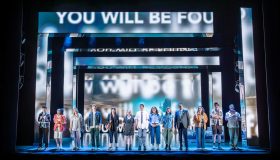Whenever pondering e-books, I feel like a nanna with a wonky walking frame. In the clash between the ambivalent and ambidextrous, I am far more trusting of a bloke in eyeliner or a chick with chest hair then the split-screened, blue-toothed, multi-platform digital evangelist.
Listening to a recent presentation by the head of e-books.com, a global company based in an affluent suburb of Perth in Western Australia, his unwavering belief that people would read books on any screen – including the micro-mobile phone – was justified by his contention that an immersion in content would render the platform invisible to the “consumer”. Supposedly, the “reader” would follow suit.
A few years ago, I would have dismissed such digital diatribes as the corporate commitment of a try-hard, dot.com-modifier. These groovy baby boomers often justify their arguments through generationalism: “the kids” are far more screen literate than the nannas who read books. It is just a matter of time before the pixels inherit the earth. For all the writers reading my words in this article, feel free to laugh at such a hypothesis. Writers would spend more hours per day lost in the glow of a back-lit screen than the sweet sixteen cyber junkies that are supposedly tech savvy. While there is a marketing assumption that every person who owns an ipod is under twenty, a recent Guardian article reported that the most prolific downloaders from i-tunes are men aged from 25 to 45. Such a fact confirms that easy ageism does not translate effectively from analogue spin into the digital discourse.
But my mind is being changed. In the last month, I have just moved everything – my entire life – from Perth in Western Australia to Eastbourne in the United Kingdom. I am still on the anti-inflammatories for my back. We did not move anything as sensible as furniture, a washing machine or even a microwave oven. Of the 122 boxes that have been packed, 89 are filled with books. A further five boxes were culled from the collection and given to my postgraduates. Through this process, old gems were rediscovered. Rare texts that changed my life and thinking were carefully moved into their transitory cardboard covering. It was hard word and an inevitable trauma awaits me: for every arduous pack there must be an equally taxing unpack.
While filling box 53, containing my weighty books on international immigration policy, I started to become a fan of e-books. No more lifting. No more physical sorting. All that would remain is the simple pleasure of immersion in content (sorry – words, sentences and ideas). I went to the e-books site to discover what my soon to be fellow e-book community was reading. No obscure scientific treatise. No passionate anarchist reaching out to other cyber fellow travelers. Instead, the top downloads read like an airport bookshop. It was all fiction, just about all of it written by Dan Brown and J.K. Rowling. My dream is to make whoever let Leonardo da Vinci and Harry Potter into publishers’ fiction lists read these “books” on a small mobile phone screen with a fading back light. There was no non fiction, and nothing scholarly, and I am using that term in its most general application. So these consumers of e-books are letting flimsy fictional content dance along their cursor.
Through the ficto-trash, there are some great benefits to scholars of e-books. I have found them useful in speed searching references to check a quotation, or to investigate the citations of others. They are quick sources for verification. But would I – would you? – read and take notes from a work of literary criticism or history, geography or media studies through this platform? It does encourage rapid reading, a gentle floating through bright text. But does this medium facilitate the level of connection required for more scholarly and intense engagements with the words and worlds of others?
Increasingly troubled, I moved on to box 54. Thankfully, I was interrupted by a gift from a postgraduate to acknowledge my departure from Perth. Gratitude was replaced by horror.
Oh no.
It was another book.
My first thought was – it is a big book – I will have to create another coffee table book box, and it is so hard to place other books around them. Clearly I needed to finish packing and recommence a normal life. Upon opening the cover – and seeing the number of fac 461 – I discovered that Felicity had given me Matthew Robertson’s new book from Thames & Hudson, Factory Records: The Complete Graphic Album. It is an object of beauty, buffed by sharp Peter Saville edges and Matt and Pat Carroll’s humour and energy. Focusing on the designs, rather than the music, of Factory Records, it is a reminder that not only is there more to music than sound, but there is more to books than content.
The first release from Factory Records – a double inch single – was not given the catalogue designation of “fac1”. That number had already been given by Saville to himself, or to his first design – a poster for the first Factory gig at the Russell Club in Manchester. This was a brilliant strategy, and served to breach the separation of the song from the packaging that had been a characteristic of popular music’s history. To make this recognition about the importance of form rather than content before the 1980s – before Duran Duran, Howard Jones and Haircut 100 – was extraordinary. That is why Factory’s music back catalogue has not only survived, but the influence of their designs continues. Robertson’s book not only adds another number to the fac-story, but juts forward the covers, the posters and the designs for a new audience. It is a glossy and confronting book, a passionate voyage through colour, typography and cropping.
As I sat with this book – not so much reading, but living its pages – I realized that the digital dreams of e-books could never replace a tome such as this. Not only are there the questions of image resolution, but of tactility. Touch is one of our most under-researched senses. While visual literacy has had strong attention for the last twenty years, built on two centuries of innovative art history and historiography, and auditory literacy is gaining recent attention from sonic media theorists, tactile and olfactory literacies remain the ugly step sisters at the Cinder-senses ball. While the slow foodies and w(h)ine tossers have colonized – a correct word choice there – literacies of taste, my hope is they will exhaust themselves shortly from their excessive use of bizarre adjectives such as “sweaty”, “bulbous” and “pungent”. Grand hand gestures, overworked vocabularies and excessive facial expressions are exhausting work for anyone, particularly when chattering about the (actual) hard work of farmers and wine makers. But touch remains thankfully untouched by the adjective eaters.
With the proliferation of e-books, more destructive discussions are emerging in libraries – or actually on the part of administrators and managers of libraries – around the world. The goal is to not only redeploy budgets from printed monographs, which has been happening for the last eight years at least, but to replace and destroy paper and print for the screen and text. In such a context, we need to think about tactile literacies and their place in the reading process. Factory Records: The Complete Graphic Album was given to me just in time. The lifting, packing and anti-inflammatories were starting to warp my judgment.
Reading is multi-sensory, not only working the ciliary muscles within our eye sockets, but also our fingertips. These senses trigger emotion and memory, constructing a network of meanings in the moment. Books are inconvenient to pack and store, but there is a micro-history of our lives invested in those pages. When we read, we are changed. Reading is not about content or text. It is not about immersion in a narrative, no matter what the platform. In returning the other senses – beyond the visual – back to the reading experience, Robertson’s fac 461 confirms that there will be no seamless or easy migration from analogue to digital. There will be loses. The replacement of fac 461 for e-fac 1.0 may play an MP3. It may provide fast hyper-linking through the document. It may scroll through a mobile phone screen. But we lose sensuality from scholarship when tactility is bladed from a text.




